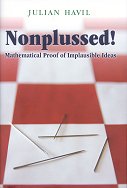The ancient Greeks discovered them, but it wasn’t until
the nineteenth century that irrational numbers were properly understood
and rigorously defined, and even today not all their mysteries have been revealed.
In The Irrationals, the first popular and comprehensive work on the subject,
Julian Havil tells the story of irrational numbers and the mathematicians
who have tackled their challenges, from antiquity to the twenty-first century.
Along the way, he explains why irrational numbers are surprisingly difficult
to define—and why so many questions still surround them.
Fascinating and illuminating, this is a book for everyone who loves math
and the history behind it.
The Irrationals – real numbers that aren’t rational – have many fascinating properties.
Havil takes us on an historical journey, from the Ancient Greek mathematicians’ geometrical investigations,
to present day deep algebraic concepts.
The earlier material is, unsurprisingly, less technically challenging, but no less interesting, than later results.
I thought I knew a reasonable amount about irrational numbers before I started (possibly more than the target audience),
but I still learned many interesting new facts.
Some of these are quite elementary (presumably I missed these back at school due to having studied a “modern maths” curriculum),
and some are more advanced.
So I learned the rational roots theorem (see p.131), which
(in its simplest form) states that, given a polynomial equation
xn + an−1xn−1 +…+ a1x + a0 = 0,
where all the coefficients ai are integers, then any rational root must be an integer that divides a0.
That’s extremely useful, as it gives a very quick constructive way to test for the existence of rational roots.
The theorem is presumably known to all children studying a more traditional maths curriculum.
This result, along with the majority of the others, is accompanied by a proof;
I confess I skimmed most of the proofs, but they are a useful resource.
We get discussions of constructing geometric figures, algebraic numbers, continued fractions,
approximating irrationals with rationals, transcendental numbers,
a “positive” definition of the irrationals (that is, not one like “all reals except for the rationals”),
a way to quantify how irrational a number is, randomness, and much more.
One result I particularly liked is the following (see p.262):
Let α be a positive irrational. Define β = α / (α−1).
Define the sets A = {floor(nα) : n=1,2,3,…}
and B = {floor(nβ) : n=1,2,3,…}. A and B partition the natural numbers;
that is they have no elements in common, and together contain all the natural numbers.
Different choices of α yield different partitions. Havil provides examples, for α = √2, π, and e.
For e, the sets are: A = {2,5,8,10,13,16,19,21,…} and B = {1,3,4,6,7,9,11,12,14,15,17,18,20,…}.
That would be fun enough but itself, but it leads on to even more fascinating results.
It is obvious we can write a formula to generate the multiples of three: f(n) = 3n.
But we can also write a formula that generates the non-multiples of three:
g(n) = floor(n/2 − ¼)+n.
The approach is general, and can be used to write formulae to generate the non-squares, the non-triangular numbers, etc.
(I just love this kind of stuff.)
From the playful subtitle, to the Appendix on how to find the tomb of Roger Apéry in Paris,
the whole book is full of gems, and is written in a very accessible manner,
provided you know a little bit of maths to start with.
Highly recommended if you like reading about maths.

